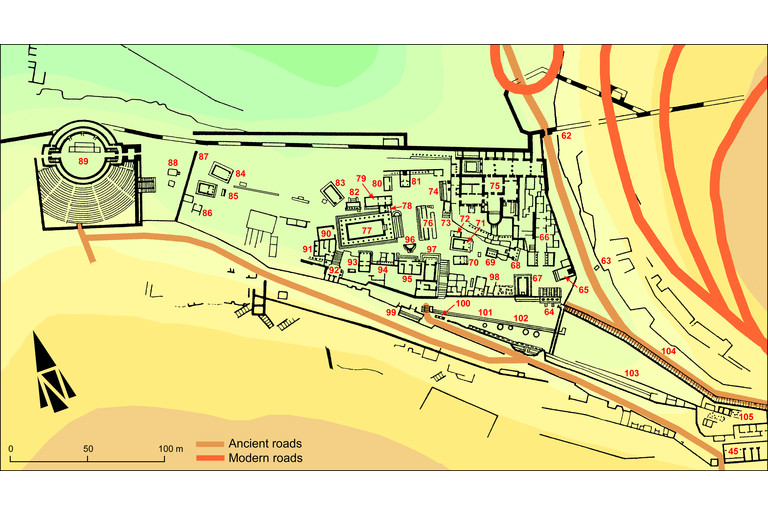Dedication of a wall to Apollo and Artemis
GVCyr031
Trismegistos ID: 738924
Source Description
Support
Rectangular block of local limestone, belonging to a wall now partly rebuilt (0.83; 0.37;0.685).
Layout
Inscribed on the face of this block and originally extending on a lost one on its right.
Letters
0.055, traces of guide-lines; lunate epsilon and sigma, cursive mu.
Place of Origin
Findspot.
Date
Second half of second century A.D. (lettering, context)
Findspot
Found in 1933 at Cyrene pleiades; HGL : amongst the collapsed blocks of the Wall of Nicodamos and placed on the top of the restored wall in 1934.
Last recorded Location
Studied by C. Dobias-Lalou in 1983 in situ.
Text constituted from
Transcription from stone (CDL).
Bibliography
Never published before. Cf. mentions by Goodchild, 1971 Goodchild, R.G., 1971, Kyrene und Apollonia, Zurich - see in bibliography , p. 125 and fig. 67; Reynolds, 1976-1977 Reynolds, J.M., 1976-1977, Inscriptions in the market theatre and its immediate neighbourhood, Libya antiqua (LibAnt)13-14, 373-375 - see in bibliography , p. 374; Ensoli, 2010 Ensoli, S., 2010, Il teatro-anfiteatro del Santuario di Apollo a Cirene, in M. Luni (ed.), Cirene e la Cirenaica nell'Antichità, Monografie di archeologia libica30, Cirene Atene d'Africa: attività delle missioni archeologiche internazionali a Cirene e in Cirenaica3, Roma, 117-145 - see in bibliography , p. 139, footnote 135.
Text
| Ἁγνείης ἀνάθημα μέλον Φοί[βῳ καὶ ἀδελφῇ]
| ἀρητήρ Νεικόδαμος ἔδειμα̣ [πρὸς ἀμφιθεάτρῳ]
| τεῖχος ἀναστήσας ἱροῖς κτ[εάτεσσι ˘ | ˉ ± ]
| μουνομάχοιο θέης ἀποκ[λείσας ἄλσεα θεῖα]
Apparatus
French translation
C'est une offrande visant à la pureté que, pour Phoibos [et sa soeur],
moi le prêtre Nikodamos, j'ai fait construire [contre l'amphithéâtre],
en érigeant un mur [---] pour les [propriétés] sacrées
isolant ainsi du spectacle des gladiateurs [les bosquets divins].
English translation
An offering aiming at purity for Phoibos [and his sister],
I, priest Nikodamos, built [close to the amphitheatre],
erecting a wall [---] for the sacred [estates],
shuting out of the view of gladiators [the divine bushes].
Italian translation
Un'offerta che aspira alla purezza per Febo [e sua sorella]
io, il sacerdote Nikodamos, ho fatto costruire, [vicino all'anfiteatro]
erigendo un muro [---] per le [proprietà] sacre
che esclude dalla vista dei gladiatori [i boschi divini].
Commentary
On basis of the lettering alone, the inscription might be dated, in J.M. Reynolds' opinion, from the second or third century. However, given the precise explanation provided by the epigram about the purpose of building the wall, it is possible to connect it with the transformation of the ancient Greek theatre into an amphitheatre. The latter is dated on archaeological grounds to the second half of the second century A.D.
The priest Nikodamos here mentioned is probably the grand-father of Anaxo daughter of Euphranor, priestess of Artemis about 180 A.D. (IRCyr C.222, l. 24). She is also mentioned with father's and grandfather's name in a dedication found in the Market Theatre, but possibly moved from elsewhere (IRCyr C.211, in the original publication of which J.M. Reynolds, through a slip of the pen mentioned Nikodamos as her father, an error later reproduced by Ensoli).
This inscription, which remained hitherto unpublished, has been long since in sight for visitors. Those who mentioned it unanimously guessed its main meaning. We do not hazard in restoring the last word of line 3, which should be a noun or an adjectif appended to τεῖχος and connected with ἱροῖς κτεάτεσσι; however this phrase may also be related directly to ἀναστήσας. We restore as a climax of the epigram the adjective θεῖος in assonance with θεῆς at the caesura.
Metrical analysis: in spite of the missing parts, we can hold for sure that there was a series of four hexameters, a composition that is a little less common than two elegiac couplets. Two poetic licences appear in the first distichon of line 2: 1) ἀρητήρ has a long first syllable, a lenghthening that is common since the Homeric poetry; 2) the rhythm of the personal name Νικόδαμος (written Νεικ- through iotacism) is ametric (+-+-); the first syllable may thus be taken as short.
Creative Commons Attributions-NonCommercial 4.0 International License.
All citation, reuse or distribution of this work must contain a link back to DOI: http://doi.org/10.6092/UNIBO/IGCYRGVCYR and the filename (IGCyr000000 or GVCyr000), as well as the year of consultation.
